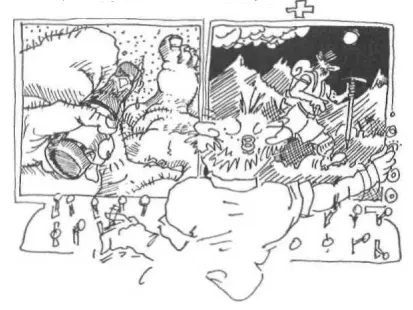Richard Bandler - Using Your Brain —for a CHANGE
- Название:Using Your Brain —for a CHANGE
- Автор:
- Жанр:
- Издательство:Real People Press
- Год:1985
- Город:Moab, Utah
- ISBN:0–911226–26–5
- Рейтинг:
- Избранное:Добавить в избранное
-
Отзывы:
-
Ваша оценка:
Richard Bandler - Using Your Brain —for a CHANGE краткое содержание
Bandler is an innovator and an original thinker in the field of psychology. This book is a transcript of Bandler live in front of an audience, cutting up and cracking jokes as he is prone to do, talking about some of his unique and often practical views on how you can change your feelings, thoughts and behavior. Change is often easier than you think if you use the right method.
Using Your Brain —for a CHANGE - читать онлайн бесплатно полную версию (весь текст целиком)
Интервал:
Закладка:
I'm telling you about these possibilities so you begin to understand how important it is to tailor your change method to each person. You want to create a direction where the old problem image leads to the solution, and the solution image creates a response of increasing intensity.
Man: My partner had a picture with a double frame — one black and one white — and the image is slanted instead of being straight up and down. The top of the image tilts away from her when she panics.
What changes? Does she bring the image up straight at some time? If the image goes back at an angle and has a border, then she panics?
Man: No, it's just there.
Well, it's not just there. It has to come from somewhere. What we are looking for here is what changes. Once she gets to the picture you described, she has panic. But the image has to start out being somewhat different. I hope she doesn't panic all the time! How does she get there? Does it have to do with the changing of the picture's angle? Or is the angle fixed and something else changes?
Man: It starts out being straight up and down, and as the situation changes, it becomes slanted.
So as the picture tilts, so does she. When it reaches a certain angle, she panics. Does the picture have the double border when it's vertical?
Man: Yes.
So the border is not a critical element, it just happens to be there. Does anything else happen as the picture tilts? Does it change brightness or anything like that? Does the speed of the images change?
Man: No. The sound also becomes sort of blurred and buzzy.
And you are sure that nothing else changes visually.
Man: No.
Good. I'm glad you're not sure. It seems like just tilting an image wouldn't be enough. You can go back and ask her. Have her take a picture of something else and tilt it and find out what happens. If just tilting any picture is enough to make her feel "off–balance" and panic, you could have the first picture tilt down to a line while the second picture tilts up to the vertical. Or you could tilt the first picture down, and then flip it all the way over to show the second picture on the other side. Take her for a real ride! Have you seen the video effects on television in which a square comes out and flips around? As it flips around it ends up being a new image. You could do it that way. Are you all beginning to understand how you can use this information to construct a swish that will be especially powerful for a particular person?
Man: My partner's problem was caused by the fact that he lost the background of what he was looking at. It just began with a lot of people in a background, and when he got to a critical place, the background was all gone; there were just people there.
Was there a change in the focus, or the depth of field?
Man: It just disappeared. I guess it's out of focus. It's not there.
But the things in the foreground are clear?
Man: They are as clear as normal; they are not changed.
Is it like looking through a lens? With a lens you can get one part to be clear and the other parts are blurred. Is that sort of what you are talking about?
Man: No, it isn't. It's as if he put a mask over everything except the people involved, and everything else disappeared.
And the people are standing on nothing?
Man: I guess the chairs and things they were sitting on would be there, but everything else in the room was cleared. The concentration was apparently on people.
OK. But you don't know how it was done — with focus or whatever?
Man: No, I don't know that.
That is the part you need to know. You want to know how the transition occurs, so that you can use that method of transition with any picture.
Woman: The fellow I was working with had a still slide, with no movement or color. When he first sees the picture, he talks in his own voice, and it's a mid–range tone of voice: "Hmmmm, not bad," the tone going down and up. Fairly quickly the voice changes and becomes monotonous and low. That's when he feels bad.
The picture remains constant? It doesn't change at all? I find it a little difficult to believe that while he changes his tone and tempo of speech, the slide remains constant — that the brightness or something else about it doesn't change — because I simply haven't found it. That doesn't mean it's not possible, but I find it very unlikely. People can lead auditorily, but usually something else changes along with the voice. Let's assume that he's looking at a picture and he just talks himself from one state to another by changing his tone of voice. That will work. You will also need another auditory parameter if you are going to do an auditory swish. Probably the tempo will change. There will usually be more than one parameter that changes.
Man: If you are looking for another variable, and could get one in another modality so you had one visual and one auditory submodality, would that mixture work?
It can, but most of the time you don't need it. You could do that if you really couldn't find a second submodality in the same system. The reason I'm emphasizing the visual system is because the visual system has the property of simultaneity. You can easily see two different pictures together at once. The auditory system is more sequential. It's hard to pay attention to two voices at once. You can do a swish auditorily, but you have to go about it a little differently. If you learn to be precise in the visual system, then when you start dealing with the auditory channel it will be easier to adapt.
Man: The reason I asked that is because with my partner the pictures change, but also as she steps into the picture, she can hear herself. I'm wondering in doing the swish whether it would sort of nail it shut by adding an auditory piece.
Yeah. "Nailing it shut" is a good way to think about it. If you do a swish with only one submodality, that's like nailing two boards together from only one direction. A dovetail joint has nails or screws going into it from two directions at once. If you pull one way, one set of nails holds it; if you pull the other way, the second set of nails holds it. That's why it's important to use two powerful submodalities simultaneously when you do the swish. People usually won't vary more than one submodality at a time on their own, and you'd have to vary at least two at once to undo a swish.
If you're doing a visual swish and there are also auditory components, typically the person will demonstrate the auditory shifts to you unconsciously as she tells you about the two pictures. Then when you are telling her to make the pictures, you can do the auditory shifts externally with your voice, without mentioning it. In order to do that well, you need to be able to speak in someone else's voice.
The skill to be able to copy someone else's voice is simply a matter of practice, and it's a talent that is well worth learning to do in this business. After a while you discover that you don't have to match someone perfectly; you just have to get a few distinct characteristics. You need enough so that if you do somebody's voice, he won't notice whether he is talking to himself or you are. It's the old pattern of, "Well I went inside and said to yourself ... " I used to do that a lot in workshops, and very few people noticed.
I want you all to go back to the same person you were with a few minutes ago, and find out the one or two analogue submodalities that are most important in creating the limitation. Some of you already have that information, but a lot of you don't.
Next I want you to get that second picture of how he would see himself differently if he no longer had the limitation. This picture must be dissociated, and the first picture will always be associated. Association in the first picture and dissociation in the second will always be one element of the swish.
Next you'll build a swish using the two analogue submodalities you've identified as important (instead of the size and brightness you used in the standard swish). First have your partner make an associated picture of the cues, using whatever submodalities create a strong response (a big, bright picture). Then have your partner make a dissociated picture of themselves as they would like to be, beginning with the other extreme of those same submodalities (a small, dim picture). When you swish, the submodalities will change so as to rapidly weaken the response to the first picture at the same time that they strengthen the response to the second picture. Come back in about half an hour.

What you have been doing is the basis for using the swish artistically and with precision. You can always just try the standard swish. If it doesn't work you can try a different one and keep going until you find one that works. That is certainly better than not trying another one. But it's even better to gather enough information so that you know exactly what you're doing, and you can predict ahead of time what will work and what won't. Do you have any questions?
Man: What do you do with a client who doesn't have much awareness of internal process? When I ask some of my clients how they do things inside, they just shrug and say, "I don't know."
There are several things you can do. One is to keep asking until they pay attention inside. Another is to ask a lot of questions and read the nonverbal "yes/no" responses. Ask, "Are you talking to yourself?" and watch the response just before the verbal "I don't know." This technique is discussed fully in the book Trance–formations.
Another thing you can do is to create the problem situation and observe the person's behavior. All submodality shifts are demonstrated in external behavior. For instance, when someone brightens a picture, the head rotates back and up, but when a picture comes closer, the head moves straight back. If you observe people when you ask them to make submodality changes, you can calibrate to the behavioral shifts that we call "submodality accessing cues." Then you can use those shifts to determine what someone is doing inside, even when he's not aware of it. I always use this calibration as a check to be sure the client is doing what I ask him to.
Like everything else in NLP, the more you know how change works, and the more you are calibrated to behavioral responses, the more you can do things covertly. For instance, sometimes a person has to practice the swish a few times. You can ask her to do it once, and then ask her, "Did you do it right?" In order to answer that question, she'll have to do it again. Then you can ask, "Are you sure you did it right?" and she'll have to do it again. She'll also do it faster and easier that way because she isn't consciously trying to do it.
Woman: Do you have any long–term follow–up studies of the effectiveness of this method?
I'm much more interested in twenty–minute follow–up studies. The only good reason for a long–term follow–up study is if you can't tell when the person changes in your office. Think about this: if you did produce a change in someone and they remained changed in that way for five years, what does that prove? That says nothing about whether or not that change is a valuable one, or whether or not it could have evolved any further. You see, making it possible for a woman to not be phobic of worms or not be compulsed to eat chocolate, is not a very profound accomplishment, even if it lasts the rest of her life. The important thing to understand about the swish pattern is that it sets the person in a direction that is generative and evolutionary. When I have done longer–term follow–ups on people I've swished, they typically report that the change I had made became the basis for all kinds of other changes that they are pleased with. The swish pattern doesn't tell people how to behave, it keeps them on the track of going toward what they want to become. To me, setting that direction is the biggest part of what change is all about.
Читать дальшеИнтервал:
Закладка:








